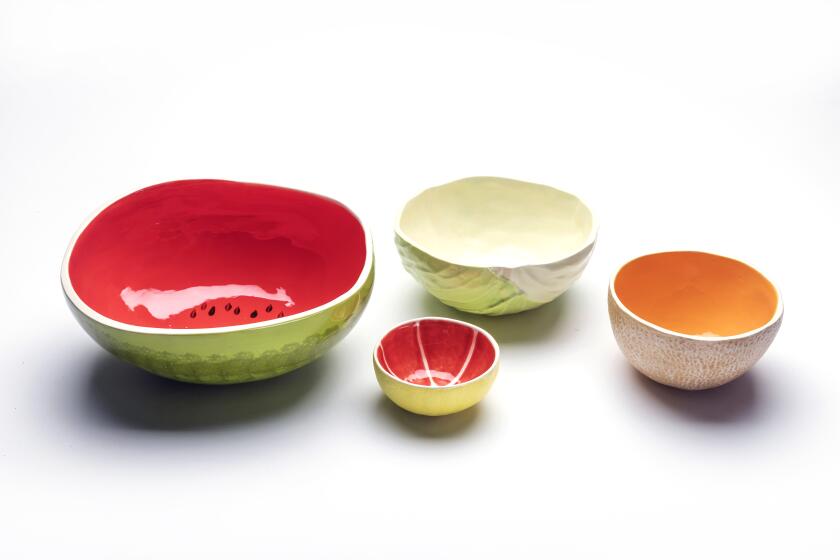Has coronavirus cut off sales outlets for your art? These gig sites can help

- Share via
If you have an artistic side and the tools to create anything from paintings to rocking horses, you may be able to make money with art and crafts. A wide array of websites can help by either marketing your creations or producing products to display them on.
Better yet, some art-based side hustles have the potential to keep making money year after year — even when your usual sales channels have been cut off by the coronavirus or you’re no longer officially working as an artist.
Sites that allow you to make money with art and crafts typically work in one of two ways. They allow you to market your art by listing it on the company’s website in exchange for paying a commission to the site. Or, you license art to a so-called print-on-demand shop. That print-on-demand company reproduces your art on products, such as coffee mugs and T-shirts. Every time a product bearing your design sells, the site pays you a royalty.
Many organizations are enlisting independent contract workers during the coronavirus outbreak.
The benefit of print-on-demand is that the site takes the risk — and much of the work — off the artist’s shoulders. You, the artist, are responsible for creating the original work of art and uploading a quality depiction of it into the site’s system.
You can also choose which products on which to make your art available. You may decide, for example, that your art works best on coffee mugs but not pillows. Duvets, not shower curtains. Baseball caps, not T-shirts.
After that, the site takes over. It will market your art-emblazoned products on the company website. When a product sells, the site produces the product; replicates your design on it; ships it and collects payment. You sit back and collect the royalties. And because your art can live on the site for years, you may be able to collect royalties long after you’ve stopped producing new art.
The flip side? Because print-on-demand shops take the risk and do most of the work, you generally keep less of the profit. Typically, the artist gets a royalty ranging from 3% to 20% of the product’s sales price.
When looking for a print-on-demand site, you should have the type of product that works well with your art in mind. Some sites specialize in paper products, while others focus on housewares and clothing.
Etsy is one of the oldest and best-established sites to sell art, crafts and hand-made items.
Two of the best print-on-demand sites for those who want to design art for housewares and clothing are Society6 and RedBubble.
Society6 pays a set 10% royalty to artists on most products. So, if a sweatshirt bearing your design sells for $38, you’d get $3.80. The one exception to that rule is for artists who want to sell prints of their work. In this case, the site simply tells the artist the site’s cost to create the print; the artist adds a custom mark-up to create the final price.
Redbubble lets artists set their own royalty rates on everything. Thus the final cost of the product equals the site’s cost, plus the artist’s royalty. The only downside to setting your royalty rate sky-high on this site is the chance that you’d make your products too pricey to be competitive and thus lose sales. Redbubble says the average royalty paid to artists on this site is 17%.
Working with restless kids underfoot is challenging and may lead to booming demand for day care when restrictions relax.
If your talent lies in creating beautiful designs or clever original sayings for greeting cards or stationery, you might want to take a look at two other print-on-demand options — Minted and Zazzle.
Zazzle says that designers are free to set their own royalty rates. But if you set your royalty over 15%, you could end up paying additional fees to the site. On the bright side, Zazzle only wants a non-exclusive license to your work. So, there is nothing to prohibit you from selling your designs here, as well as on other sites. That allows you to see where your greeting cards and stationery sell the best.
Minted operates completely differently. To offer products on Minted, you must first participate in a contest. If you are among the contest winners, you will get a cash prize and a shop where you can feature your designs. You typically earn a 6% royalty on each sale.
The bad news? Minted’s prize winners give Minted an exclusive right to sell the award-winning work, says Kiffanie Stahle, a lawyer who blogs at TheArtistsJD. To be sure, prize earnings can be substantial — $1,000 to $3,500 for first place. But you give up your right to sell elsewhere even when you win a smaller prize, such as $50.
So, think carefully before entering your favorite designs in a Minted Challenge.
Of course, you can also create greeting cards and stationery and sell them on sites such as Etsy that only do marketing for you.
Remote jobs for the coronavirus era range from teaching to writing to web development.
When you list products on Etsy, you design, produce, price and ship the product. The site simply provides a means to advertise your original creations for sale.
And while Etsy sells plenty of paper products, the site is better known for selling hand-made crafts, including jewelry, custom furniture, leather products, lamps, paintings and other unique items.
The site’s listing fees are modest — 20 cents per item. Your listings remain live for four months or until the item sells, whichever comes first. When you sell items, Etsy also takes a 5% commission.
Animators and graphic artists are best served by WorkingNotWorking, a hub for “digital creatives,” such as web and logo designers, animators and movie makers. WorkingNotWorking connects companies that need help with the digital creatives that can provide it, putting the cost of the site’s services on the companies, not the talent.
Kristof is the editor of SideHusl.com, an independent site that reviews hundreds of money-making opportunities in the gig economy.
More to Read
Inside the business of entertainment
The Wide Shot brings you news, analysis and insights on everything from streaming wars to production — and what it all means for the future.
You may occasionally receive promotional content from the Los Angeles Times.












